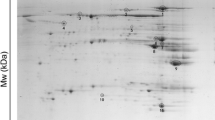Summary
The principle of a method for differentiating between fresh and frozen/thawed meat is based on the fact that freezing and thawing of muscle tissue results in a release of mitochondrial enzymes from the mitochondrion into the sarcoplasm; the appearance of activity of mitochondrial enzymes in the muscle press juice indicates that the meat was frozen and thawed. For a frozen meat test of this type, the mitochondrial enzyme chosen must fulfill the following requirements (a) it should be released by freezing and thawing but not during storage of meat under refrigeration (meat ageing); (b) the total activity should not decrease markedly during storage of meat either fresh or frozen; and (c) it should be easily detectable in the muscle press juice. Among the enzymes investigated, citrate synthase and β-hydroxyacyl-CoA-dehydrogenase (HADH) meet these criteria. HADH was selected for the frozen-meat test because of practical reasons. The experimental conditions for the assessment of the HADH activity in muscle press juice either by photometric determination or by a colour test are somewhat different according to the type of meat. The HADH test can be applied to the meat of cattle, pigs, sheep, game and poultry. Problems of application of the method to chopped meat are discussed.
Zusammenfassung
Das Prinzip einer Methode zur Unterscheidung zwischen Frischfleisch und aufgetautem Gefrierfleisch beruht darauf, daß Mitochondrien-Enzyme durch Gefrieren und Auftauen von Muskel-gewebe aus dem Mitochondrion in das Sarkoplasma freigesetzt werden; das Auftreten der Aktivität mitochondrialer Enzyme in Muskelpreßsaft läßt erkennen, daß es sich um aufgetautes Gefrierfleisch und nicht um Frischfleisch handelt. Um für einen Gefrierfleisch-Nachweis dieser Art geeignet zu sein, muß ein Mitochondrien-Enzym folgende Voraussetzungen erfüllen: (a) Es soll durch Gefrieren und Auftauen, nicht aber während Kühllagerung des Fleisches (Fleischreifung) freigesetzt werden; (b) die Gesamtaktivität des Enzyms sollte während Lagerung des Fleisches in frischem oder gefrorenem Zustand nicht wesentlich abnehmen; (c) die Enzymaktivität soll im Preßsaft des Fleisches verhältnismäßig leicht nachzuweisen sein. Von den untersuchten Enzymen entsprachen Citrat-synthase und β-Hydroxyacyl-CoA-dehydrogenase (HADH) diesen Anforderungen. Aus praktischen Gründen wurde der HADH der Vorzug gegeben. Die experimentellen Bedingungen der Ermittlung der HADH-Aktivität im Preßsaft durch photometrische Bestimmung oder einen Farb-Test müssen je nach Fleischart etwas modifiziert werden. Der HADH-Gefrierfleisch-Nachweis ist auf das Fleisch von Rind, Schwein, Schaf, Wild und Geflügel anwendbar. Die Frage nach der Anwendbarkeit auf Hackfleisch wird diskutiert.
Similar content being viewed by others
Literatur
Gottesmann P, Hamm R (1984) Z Lebensm Unters Forsch 178:366
Gottesmann P, Hamm R (1984) Z Lebensm Unters Forsch 178:371
Hamm R, Gottesmann P (1984) Z Lebensm Unters Forsch 178:376
Hamm R, Gottesmann P (1984) Z Lebensm Unters Forsch 179:205
Gottesmann P, Hamm R (1984) Z Lebensm Unters Forsch 179:301
Hamm R, Gottesmann P (1985) Z Lebensm Unters Forsch 181:121
Gottesmann P, Hamm R (1985) Z Lebensm Unters Forsch 181:128
Hamm R, Gottesmann P (1985) Z Lebensm Unters Forsch 181:210
Gottesmann P, Hamm R (1985) Z Lebensm Unters Forsch 181:293
Hamm R, Gottesmann P (1985) Z Lebensm Unters Forsch 181:299
Gottesmann P, Hamm R (1985) Z Lebensm Unters Forsch 181:404
Gottesmann P, Hamm R (1985) Z Lebensm Unters Forsch 181:478
Gottesmann P, Hamm R (1982) Fleischwirtschaft 62:1301
Gottesmann P, Hamm R (1986) Fleischwirtschaft 66:552
Gottesmann P, Hamm R (1986) Fleischwirtschaft (im Druck)
Gottesmann P, Hamm R (1986) Fleischwirtschaft 66:1267
Gottesmann P, Hamm R (1987) Z Lebensm Unters Forsch 184:18–24
Demmer W, Werkmeister K (1985) Arch Lebensmittelhyg 36:1
Author information
Authors and Affiliations
Rights and permissions
About this article
Cite this article
Gottesmann, P., Hamm, R. Grundlagen einer enzymatischen Methode zur Unterscheidung zwischen Frischfleisch und aufgetautem Gefrierfleisch. Z Lebensm Unters Forch 184, 115–121 (1987). https://doi.org/10.1007/BF01042084
Received:
Issue Date:
DOI: https://doi.org/10.1007/BF01042084




